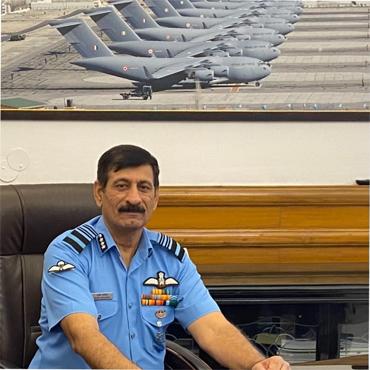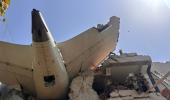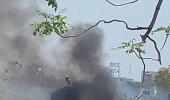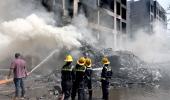'A Mayday at 600-800 feet followed by descent to 450 feet suggests the pilot still had control.'
'Until the black box is decoded, no one -- not Air India, DGCA or ATC -- can say what truly happened.'

The tragic crash of an Air India flight near Ahmedabad on Thursday afternoon has stunned aviation experts and the public alike, as early indicators suggest a highly unusual mid-air failure shortly after takeoff.
While official details remain scarce, the incident has already triggered widespread speculation -- with many questioning whether both engines failed at a low altitude, something experts deem extraordinarily rare.
Speaking to Prasanna D Zore/Rediff, Air Marshal Rajeev Sachdeva (retd), a veteran who served the Indian Air Force for 39 years with over 7,300 hours of flying experience, urges caution against premature conclusions, pointing out that "neither airplanes are designed to fail like this, nor are pilots untrained."
The air marshal emphasised that the aircraft -- a Boeing 787 Dreamliner -- is globally regarded as safe, and such failures, especially during the critical 600 to 800 feet phase after takeoff, are unprecedented.
Even a dual engine failure at that stage, he stressed, is "just not possible" without some extreme contributing factor.
As the aviation regulator DGCA begins its probe, all eyes are now on the recovery and decoding of the black box -- the cockpit voice and flight data recorders -- which Air Marshal Sachdeva said would be crucial to understanding what happened.
"Till then," he adds, "no one, not even Air India, can explain this crash."
Air Marshal Sachdeva, could you help us understand what could have gone wrong in the Air India crash near Ahmedabad, based on the video and preliminary information?

First of all, a crash like this never happens -- neither are the airplanes designed for that, nor are the pilots untrained.
With 8,000 hours of experience and 1,100 hours on the other side, that's about 10,000 hours in the cockpit. They must have trained for emergencies like engine failures.
The envelope of the first 1,500 feet after takeoff is a critical phase. Pilots are very well trained and alert during that phase.
I believe this incident happened at 600 or 800 feet. The pilot is trained to handle any emergency in this phase. Even if an engine fails, he can come back and land.
We've had 777s do that -- one of our batchmates came back safely after an engine failure.
About the Mayday call, I don't know whether it was given.
If a Mayday was called at 600-800 feet, and then the aircraft descended to about 450 feet based on the information that is coming out, it still seems to have been under control. That means the pilot had control of the aircraft -- it's called a 'controlled flight.'
 IMAGE: Air Marshal Rajeev Sachdeva (retd). Photograph: Kind courtesy Air Marshal Rajeev Sachdeva/Linkedin
IMAGE: Air Marshal Rajeev Sachdeva (retd). Photograph: Kind courtesy Air Marshal Rajeev Sachdeva/LinkedinIt doesn't happen like that -- neither are the airplanes designed to fail like this, nor are pilots. It's maybe one in a million that an accident like this happens.
Even if both engines fail, it is just not possible for an aircraft to be technically cleared, start up, taxi, open full power, take off -- and then both engines fail. It doesn't happen. It happened in the Hudson River case because of birds, but not in an open airfield like this.
Until the CVR (Cockpit Voice Recorder) and FDR (Flight Data Recorder) -- what you call the black box -- are recovered and decoded, we won't know what the pilots were saying, what exactly happened, or whether both engines failed. It just doesn't happen like that at 600 to 800 feet.
As of now, would it be fair to say no one -- not even Air India or the DGCA -- can give any concrete explanation until the black boxes are recovered?
Absolutely nothing can be known till the black box is decoded. Not Air India, not DGCA, not even ATC can say anything definitive yet.
There's some controversy regarding the Boeing 787 Dreamliner. Could you tell us about the aircraft's safety record, especially since it was the aircraft involved in this crash?
No, no -- it's a safe airplane. The 787 is flying all over.
Let me tell you -- no airplane is designed to crash in the air. All airplanes are safe.
I heard someone saying there was a snag on this aircraft, and it was rectified. That's normal. All aircraft land back, the pilot files a snag report, and these are rectified before the next flight.
What about the current FAA whistleblower investigation involving the 787 Dreamliner? Could that be a concern here?
As soon as the FAA -- which is an American agency -- gets involved in such investigations, they ground all affected aircraft across the world.
If you remember the 737 Max issue, when it had that autopilot oscillation problem, planes crashed. The FAA grounded every single 737 Max globally, fixed the issue, and then let them fly again.
If there's any credible threat, they act fast and globally. It's not like crashes will keep happening while investigations are ongoing.
Honestly, I believe this is one of those one-in-a-million cases. Let the black box come out. We'll have to hold our horses until then.











